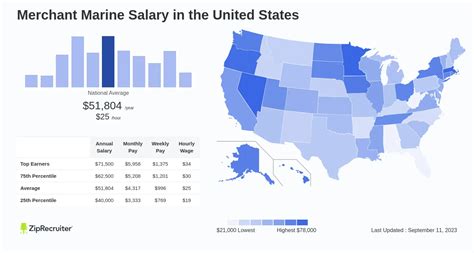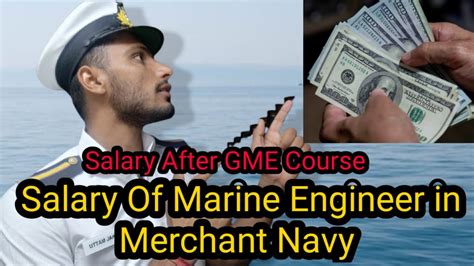For those drawn to the open sea, global travel, and a non-traditional work environment, a career in the U.S. Merchant Marine presents a compelling and uniquely rewarding path. But beyond the adventure, this critical industry offers significant financial opportunities. So, what salary can a Merchant Marine expect? From skilled entry-level positions to seasoned captains, annual earnings can range from approximately $50,000 to well over $200,000, making it one of the most lucrative hands-on professions available today.
This guide will provide a detailed breakdown of Merchant Marine salaries, exploring the key factors that influence your earning potential and the overall outlook for this vital career.
What Does a Merchant Marine Do?

First, it’s essential to understand what the Merchant Marine is. Contrary to a common misconception, it is not a branch of the military. The U.S. Merchant Marine is a civilian workforce of mariners who operate and maintain U.S.-registered commercial vessels. These ships transport cargo, passengers, and goods across the globe and on domestic waterways.
The work is typically divided into two main departments:
- Deck Department: Responsible for navigation, vessel maneuvering, and cargo operations. Roles include Captain (Master), Chief Mate, Second and Third Mates, and Able and Ordinary Seamen.
- Engine Department: Responsible for the propulsion, power generation, and mechanical systems of the ship. Roles include Chief Engineer, First, Second, and Third Assistant Engineers, and Oilers.
Mariners work on a rotational schedule, often spending weeks or months at sea followed by an equivalent amount of time off on land.
Average Merchant Marine Salary

Because the "Merchant Marine" encompasses a wide variety of roles with different levels of responsibility, a single average salary can be misleading. However, we can establish a strong baseline using data from authoritative sources.
The U.S. Bureau of Labor Statistics (BLS) groups most of these roles under "Water Transportation Workers," reporting a median annual salary of $67,730 as of May 2023. The lowest 10% earned less than $40,110, while the top 10% earned more than $112,660.
However, this figure combines unlicensed entry-level sailors with highly paid licensed officers. A more practical view comes from salary aggregators and breaking down roles:
- Salary.com reports a median salary for a "Ship Captain" of $135,108, with a typical range falling between $113,677 and $164,136.
- Glassdoor estimates the total pay for a "Merchant Marine Officer" to be around $116,339 per year, with a likely range between $89,000 and $152,000.
These figures illustrate that while the overall median is solid, specializing and advancing to an officer-level position is the key to unlocking the highest earning potential in this field.
Key Factors That Influence Salary

Your salary as a mariner is not a fixed number. It’s determined by a combination of factors, from your credentials to the type of ship you work on.
Level of Education and Licensing
This is arguably the most significant factor. Your U.S. Coast Guard (USCG) license dictates your position and, therefore, your pay.
- Unlicensed Mariners: These are entry-level positions like Ordinary Seaman or Wiper. They require basic certifications (STCW) but no college degree. Their roles are focused on maintenance, watch-standing, and general labor. The BLS reports a median salary of $59,100 for "Sailors and Marine Oilers."
- Licensed Officers: These mariners hold advanced credentials allowing them to serve as Mates or Engineers. There are two primary paths to becoming an officer:
1. Maritime Academies: Graduating from a four-year institution like the U.S. Merchant Marine Academy or a state maritime academy provides a bachelor's degree and a Third Mate or Third Assistant Engineer license. Graduates start at significantly higher salaries.
2. "Hawsepiping": This involves starting in an unlicensed role and accumulating the required sea time and passing rigorous USCG exams to earn an officer's license.
An officer's license is a direct ticket to higher pay brackets.
Years of Experience
Experience is directly tied to advancement. As you accumulate "sea time" (days spent working on a vessel), you become eligible to test for higher-level licenses. Each promotion comes with a substantial pay raise.
- Entry-Level Officer (e.g., Third Mate/Engineer): May start in the $75,000 - $95,000 range.
- Mid-Career Officer (e.g., Second Mate/Engineer): With a few years of experience, earnings can climb to $100,000 - $130,000.
- Senior Officer (e.g., Chief Mate/First Assistant Engineer): These highly experienced mariners can earn $140,000 - $180,000+.
- Master (Captain) and Chief Engineer: At the top of the profession, these leaders command the highest salaries, often exceeding $200,000 per year, especially on large vessels.
Geographic Location
While mariners work globally, the location of their employer and union hall can impact pay. Major U.S. port cities like Houston, New Orleans, New York/New Jersey, Long Beach, and Seattle are hubs for shipping companies and maritime unions, which often set prevailing wage scales. Furthermore, mariners working on "Jones Act" vessels (trading between U.S. ports) may see different pay structures compared to those in international trade.
Company Type and Union Status
The type of company you work for plays a huge role in your compensation and benefits.
- Union vs. Non-Union: Maritime unions (like the American Maritime Officers or the Seafarers International Union) negotiate collective bargaining agreements that dictate wages, benefits, and working conditions. Union jobs often have higher, more standardized pay scales and robust pension and medical plans.
- Company Sector:
- Oil and Gas: Working on tankers or for energy companies often pays a premium due to the nature of the cargo and the high demand for skilled crews.
- Government Contracts: Companies operating vessels for the U.S. Navy's Military Sealift Command (MSC) offer competitive federal-level pay, job security, and excellent benefits.
- Container Shipping: Working for major international carriers like Maersk Line or Crowley provides stable work tied to global commerce.
- Inland and Coastal: Jobs on tugboats, barges, and ferries on rivers and coastlines have different pay scales, often paid by the day, but allow mariners to be closer to home.
Area of Specialization
Your department and the type of vessel you work on are critical.
- Deck Officers (Mates & Captains): The BLS reports a median salary of $85,890 for "Captains, Mates, and Pilots of Water Vessels."
- Engine Officers (Engineers): Engineers are in extremely high demand. The BLS reports their median salary at $87,170, slightly higher than their deck counterparts, reflecting this demand.
- Specialized Vessels: Working on ships with complex systems, such as LNG (Liquefied Natural Gas) carriers or Dynamic Positioning (DP) vessels used in the offshore industry, requires additional certifications and commands a significant salary premium.
Job Outlook

The career outlook for merchant mariners is stable. According to the U.S. Bureau of Labor Statistics, employment for Water Transportation Workers is projected to grow 1 percent from 2022 to 2032. While this is slower than the average for all occupations, it does not tell the whole story.
The maritime industry is facing a wave of retirements, creating a consistent demand for new, qualified talent. This is especially true for licensed officers, particularly in the engine department. For those who invest in the education and training to become a licensed officer, the job prospects are excellent. As long as global trade continues, there will be a need for skilled mariners to crew the vessels that make it possible.
Conclusion

A career in the Merchant Marine is more than just a job; it's a lifestyle that offers unparalleled experiences and outstanding financial rewards. While entry-level salaries are competitive, the path to a six-figure income is clear and attainable through experience, licensing, and specialization.
Key Takeaways for Aspiring Mariners:
- High Earning Potential: Salaries can progress from around $50,000 to over $200,000.
- Licensing is Everything: The single most important factor for high pay is earning a USCG officer's license.
- Experience Pays: Every promotion, from Third Mate to Captain, brings a significant salary increase.
- Demand is Strong: The industry has a stable outlook with high demand for qualified officers.
For individuals with a strong work ethic, a sense of adventure, and the discipline to pursue advanced qualifications, the Merchant Marine offers a lucrative and deeply fulfilling career journey.
